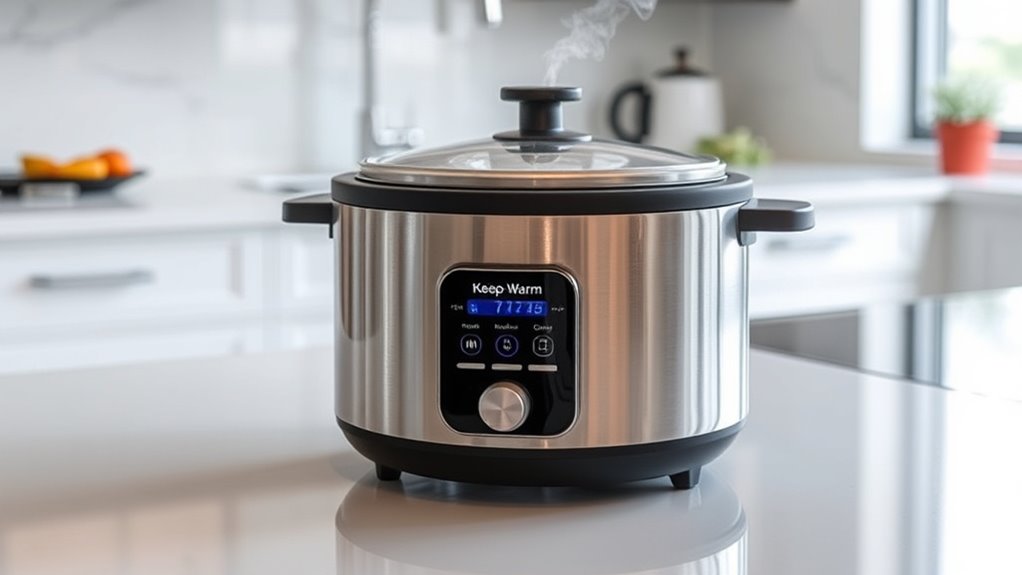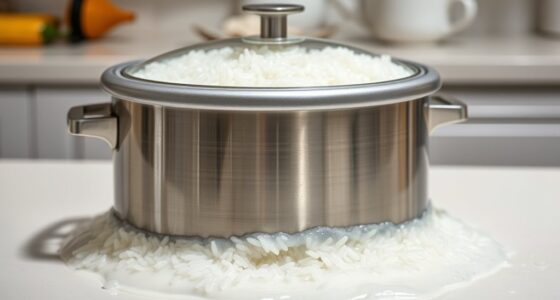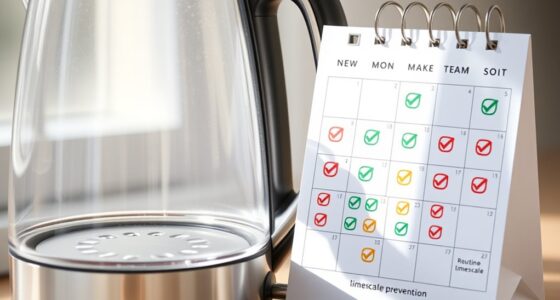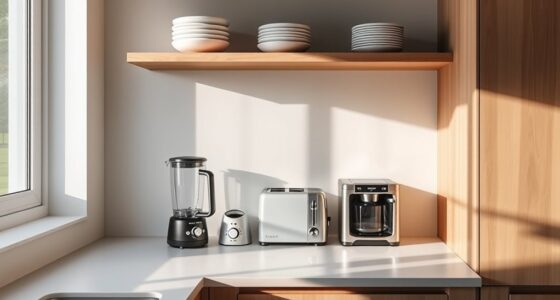You should keep rice warm in your rice cooker for no longer than 12 hours to guarantee food safety. After this time, bacteria can grow, and the risk of spoilage increases. If you plan to save leftovers, transfer the rice to the refrigerator promptly and reheat thoroughly before eating. Proper maintenance and timely leftovers storage are key to staying safe. Keep going for more tips on keeping your rice safe and delicious.
Key Takeaways
- Keep-warm should be used for no longer than 12 hours to minimize food safety risks.
- Bacterial growth increases significantly after 12 hours of warm storage.
- Regularly clean and maintain your rice cooker to ensure safe keep-warm operation.
- Transfer leftovers to airtight containers and refrigerate if not consumed within 12 hours.
- Reheat rice thoroughly and consume promptly after extended warm storage to ensure safety.
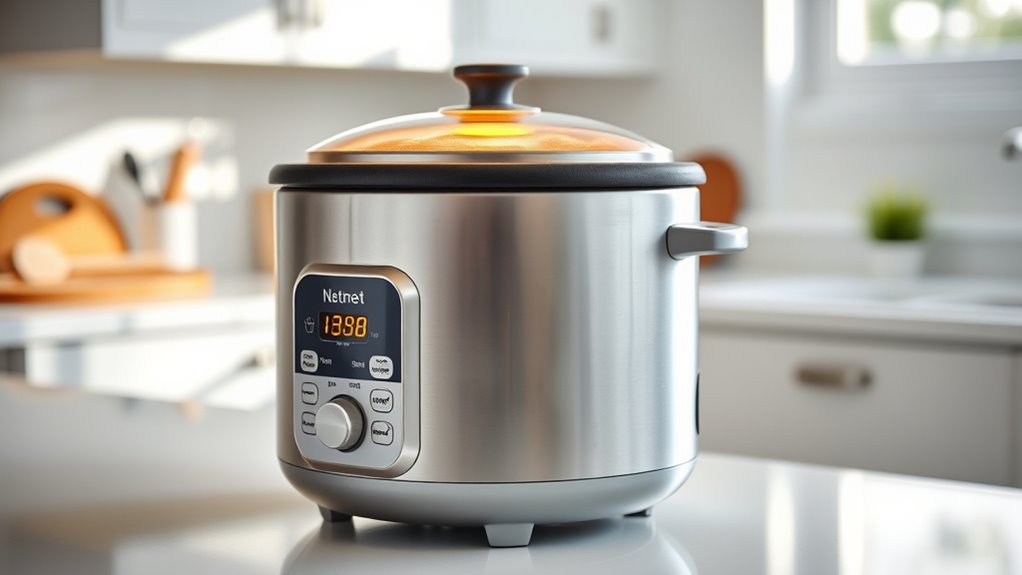
Using the keep-warm function on your rice cooker can be convenient, but it also requires caution to guarantee safety. When you rely on this feature, you need to be mindful of food safety concerns, especially regarding how long the rice stays warm. Bacterial growth can occur if rice remains at unsafe temperatures for too long, making it important to understand the recommended time limits. Typically, most rice cookers are designed to keep rice warm for up to 12 hours. After this period, the risk of foodborne illness increases, so it’s best to consume the rice within this window or refrigerate it promptly if you intend to store leftovers. Proper appliance maintenance plays a key role in ensuring safe keep-warm operation. Regularly cleaning your rice cooker prevents the buildup of mold, bacteria, and food residues that can compromise both safety and performance. Make sure to follow the manufacturer’s instructions for cleaning, especially the heating plate and seal areas, which are prone to grime accumulation. A well-maintained appliance not only keeps your rice warm safely but also prolongs its lifespan and maintains consistent heating performance. Additionally, avoiding prolonged warm storage can help prevent bacterial growth and spoilage. It’s also important to understand that the keep-warm function isn’t meant for long-term storage. While it might seem convenient to leave rice on warm all day, doing so can cause it to dry out, become overly sticky, or develop an unpleasant odor. Over time, the rice may also enter a zone where bacteria thrive, especially if the temperature fluctuates or the appliance isn’t functioning properly. To avoid these issues, consider transferring leftover rice to airtight containers and refrigerating it if you plan to eat it later. When reheating, make sure the rice is heated thoroughly to kill any bacteria that may have grown during the warming period. Ultimately, your goal should be to balance convenience with food safety. Keep an eye on the duration the rice stays warm, and practice good appliance maintenance by cleaning your rice cooker regularly. This combination helps ensure that your rice remains safe to eat and that your appliance continues to operate efficiently. Remember, the keep-warm function is a helpful feature, but it’s not a substitute for proper food handling and storage practices. By following these guidelines, you can enjoy warm rice safely without risking health issues.
Frequently Asked Questions
Can I Leave Rice in the Cooker Overnight Safely?
You shouldn’t leave rice in the cooker overnight for food safety reasons. Bacteria can grow quickly if rice stays warm for too long, especially beyond 4-6 hours. For overnight storage, it’s safer to transfer the rice to an airtight container and refrigerate it promptly. This helps prevent bacteria growth and keeps your rice fresh and safe to eat later. Always prioritize proper storage to avoid foodborne illnesses.
Does the Keep-Warm Setting Affect Rice Quality Over Time?
Yes, using the keep-warm setting can affect rice quality over time. It maintains temperature stability, but prolonged use can lead to moisture loss, making rice dry and less appealing. If you leave rice on keep-warm for too long, it may also develop a crust or become overly sticky. To preserve flavor and texture, it’s best to eat rice within a few hours or transfer it to storage once it’s done.
Are There Specific Rice Cooker Brands With Better Safety Features?
Some brands like Zojirushi, Instant Pot, and Cuckoo stand out for their safety features, backed by strong brand reputation and safety certifications. You should look for models with auto shut-off, cool-touch exteriors, and certified safety standards. These features help prevent accidents and guarantee safe use during the keep-warm cycle. Choosing reputable brands with proper safety certifications gives you peace of mind, making your rice cooker safer for everyday use.
How Often Should I Clean My Rice Cooker’s Keep-Warm Function?
Think of your rice cooker’s keep-warm function as a gentle guardian of your meal. To keep it shining like a star, clean it at least once a week. Regular cleaning removes residue and prevents bacteria buildup. Follow simple maintenance tips—wipe the lid, inner pot, and steam vent—to guarantee safety and efficiency. This routine keeps your cooker performing like new and your meals always tasty and safe.
Is It Safe to Reheat Rice in the Rice Cooker?
Reheating rice in your rice cooker is safe if you follow proper food safety and reheating guidelines. Make sure to reheat the rice thoroughly to at least 165°F to kill bacteria. Avoid reheating rice more than once, as bacteria can grow quickly with improper storage. Always store leftover rice in the fridge within two hours of cooking, and reheat only the amount you plan to eat to prevent foodborne illnesses.
Conclusion
Remember, patience is a virtue. While keeping your rice warm is convenient, don’t let it sit too long—generally, no more than 12 hours—to avoid health risks. If you keep an eye on the time, you’ll enjoy safe, delicious rice every time. Trust your instincts and don’t take chances—it’s better to be safe than sorry. As the saying goes, “A stitch in time saves nine,” so always prioritize safety first.
